FIN203 Corporate Finance: Financial Analysis and Strategy of FMG
VerifiedAdded on 2023/06/03
|9
|1523
|52
Report
AI Summary
This report provides a comprehensive financial analysis of Fortescue Metals Group (FMG), a major iron ore producer. It examines FMG's business operations, focusing on its reliance on iron ore and diversification efforts into other minerals like lithium. The report includes computations of the cash conversion cycle, analysis of financing sources with a focus on equity financing, bond valuation, and the impact of credit rating downgrades. Furthermore, the report employs the CAPM and dividend discount model to assess the intrinsic value of FMG's stock. A capital budgeting exercise analyzes two projects (A and B) using NPV, IRR, and discounted payback period criteria, recommending Project B based on superior financial metrics. The analysis also considers the impact of asset sales on project selection. The document includes references to support the analysis and is intended to provide insights into FMG's financial health and investment potential. Find more solved assignments like this on Desklib.
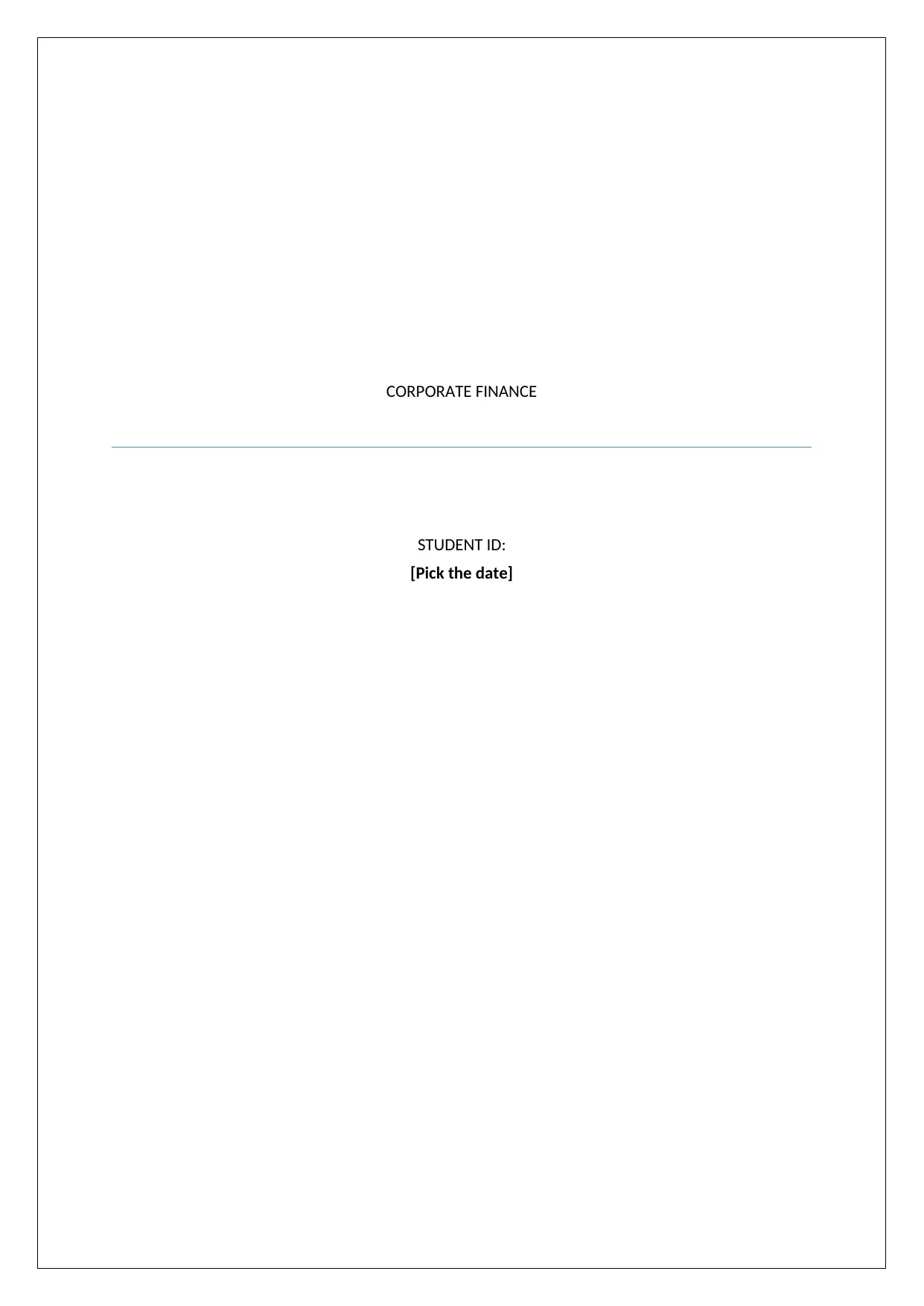
CORPORATE FINANCE
STUDENT ID:
[Pick the date]
STUDENT ID:
[Pick the date]
Paraphrase This Document
Need a fresh take? Get an instant paraphrase of this document with our AI Paraphraser
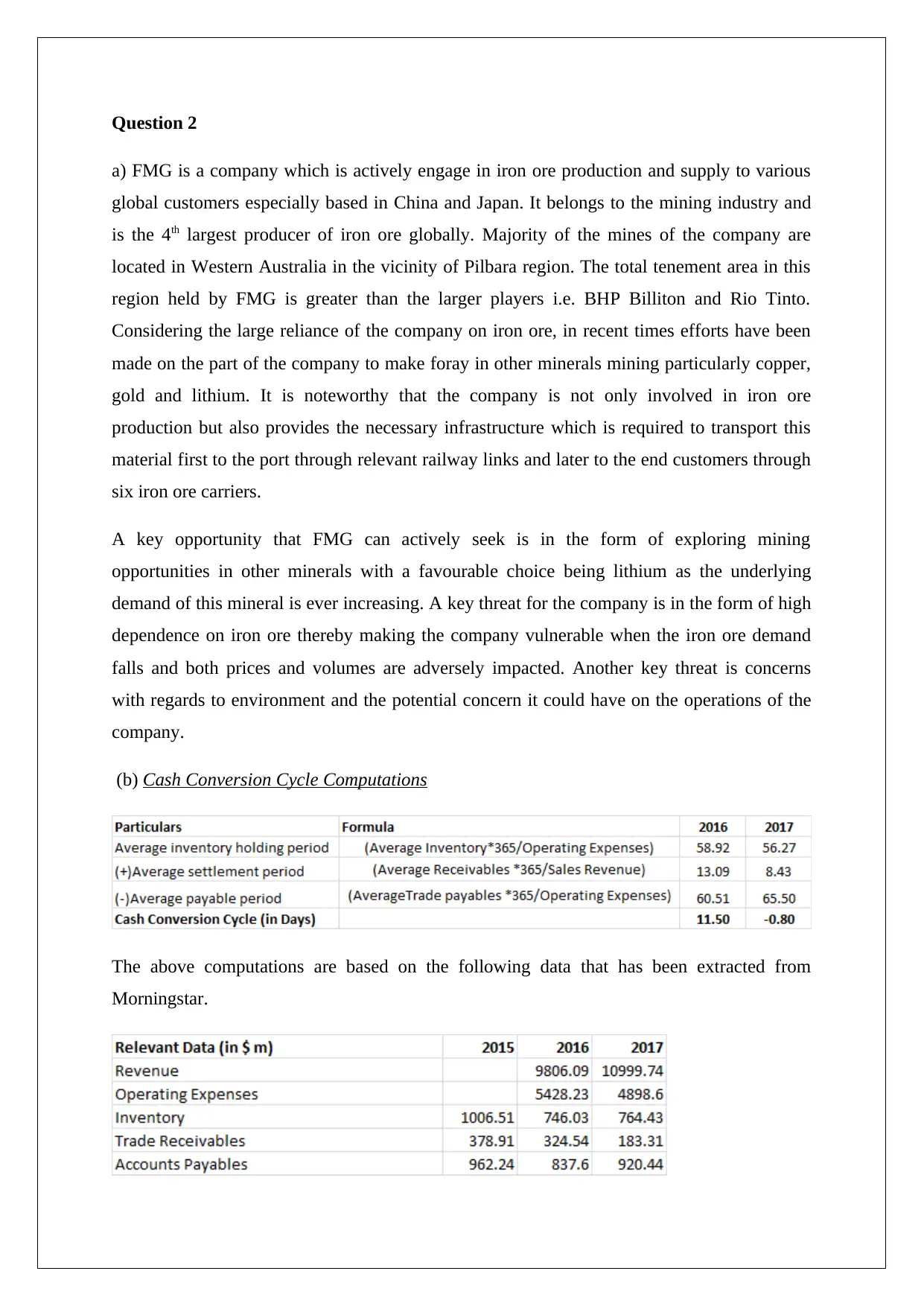
Question 2
a) FMG is a company which is actively engage in iron ore production and supply to various
global customers especially based in China and Japan. It belongs to the mining industry and
is the 4th largest producer of iron ore globally. Majority of the mines of the company are
located in Western Australia in the vicinity of Pilbara region. The total tenement area in this
region held by FMG is greater than the larger players i.e. BHP Billiton and Rio Tinto.
Considering the large reliance of the company on iron ore, in recent times efforts have been
made on the part of the company to make foray in other minerals mining particularly copper,
gold and lithium. It is noteworthy that the company is not only involved in iron ore
production but also provides the necessary infrastructure which is required to transport this
material first to the port through relevant railway links and later to the end customers through
six iron ore carriers.
A key opportunity that FMG can actively seek is in the form of exploring mining
opportunities in other minerals with a favourable choice being lithium as the underlying
demand of this mineral is ever increasing. A key threat for the company is in the form of high
dependence on iron ore thereby making the company vulnerable when the iron ore demand
falls and both prices and volumes are adversely impacted. Another key threat is concerns
with regards to environment and the potential concern it could have on the operations of the
company.
(b) Cash Conversion Cycle Computations
The above computations are based on the following data that has been extracted from
Morningstar.
a) FMG is a company which is actively engage in iron ore production and supply to various
global customers especially based in China and Japan. It belongs to the mining industry and
is the 4th largest producer of iron ore globally. Majority of the mines of the company are
located in Western Australia in the vicinity of Pilbara region. The total tenement area in this
region held by FMG is greater than the larger players i.e. BHP Billiton and Rio Tinto.
Considering the large reliance of the company on iron ore, in recent times efforts have been
made on the part of the company to make foray in other minerals mining particularly copper,
gold and lithium. It is noteworthy that the company is not only involved in iron ore
production but also provides the necessary infrastructure which is required to transport this
material first to the port through relevant railway links and later to the end customers through
six iron ore carriers.
A key opportunity that FMG can actively seek is in the form of exploring mining
opportunities in other minerals with a favourable choice being lithium as the underlying
demand of this mineral is ever increasing. A key threat for the company is in the form of high
dependence on iron ore thereby making the company vulnerable when the iron ore demand
falls and both prices and volumes are adversely impacted. Another key threat is concerns
with regards to environment and the potential concern it could have on the operations of the
company.
(b) Cash Conversion Cycle Computations
The above computations are based on the following data that has been extracted from
Morningstar.
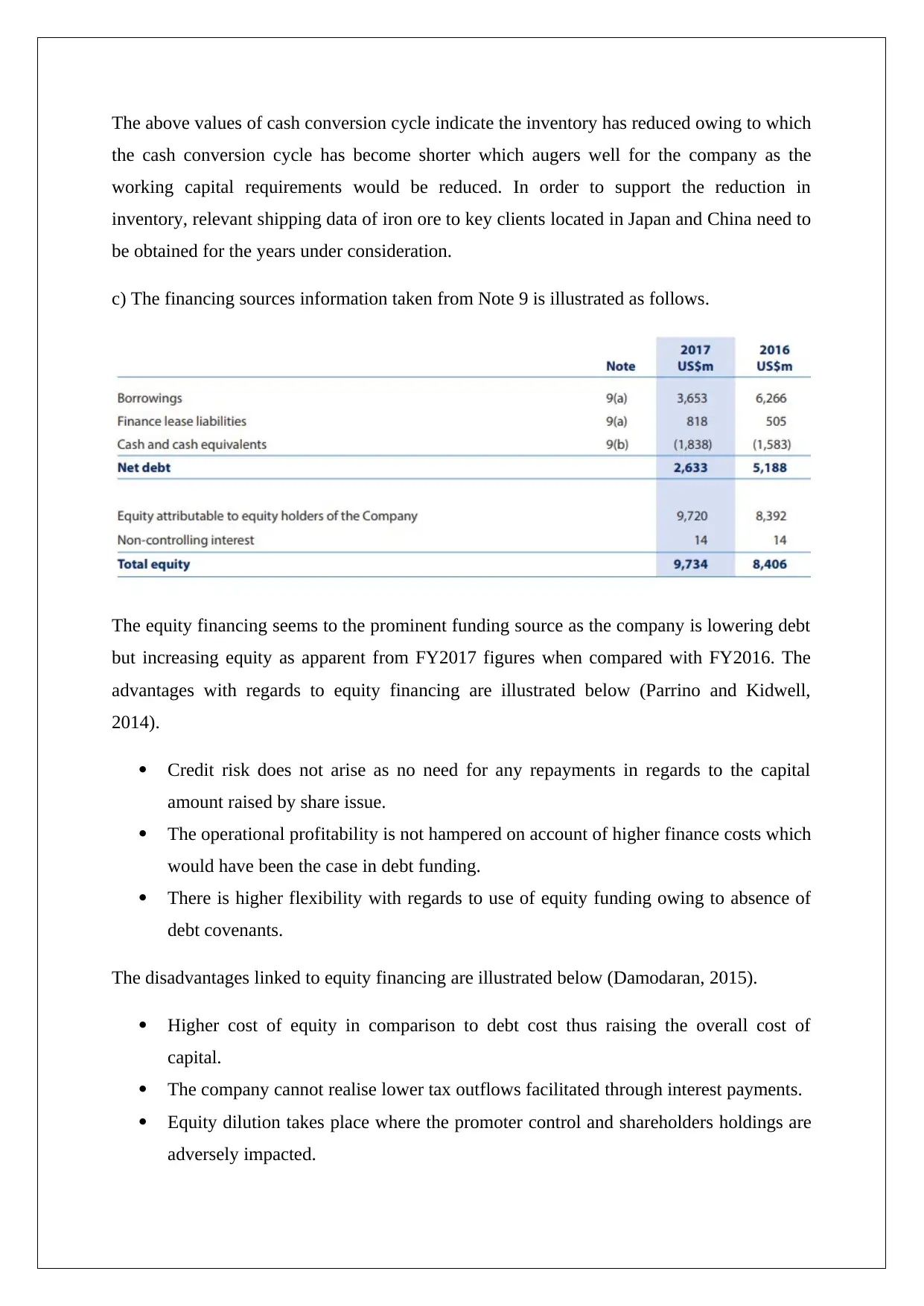
The above values of cash conversion cycle indicate the inventory has reduced owing to which
the cash conversion cycle has become shorter which augers well for the company as the
working capital requirements would be reduced. In order to support the reduction in
inventory, relevant shipping data of iron ore to key clients located in Japan and China need to
be obtained for the years under consideration.
c) The financing sources information taken from Note 9 is illustrated as follows.
The equity financing seems to the prominent funding source as the company is lowering debt
but increasing equity as apparent from FY2017 figures when compared with FY2016. The
advantages with regards to equity financing are illustrated below (Parrino and Kidwell,
2014).
Credit risk does not arise as no need for any repayments in regards to the capital
amount raised by share issue.
The operational profitability is not hampered on account of higher finance costs which
would have been the case in debt funding.
There is higher flexibility with regards to use of equity funding owing to absence of
debt covenants.
The disadvantages linked to equity financing are illustrated below (Damodaran, 2015).
Higher cost of equity in comparison to debt cost thus raising the overall cost of
capital.
The company cannot realise lower tax outflows facilitated through interest payments.
Equity dilution takes place where the promoter control and shareholders holdings are
adversely impacted.
the cash conversion cycle has become shorter which augers well for the company as the
working capital requirements would be reduced. In order to support the reduction in
inventory, relevant shipping data of iron ore to key clients located in Japan and China need to
be obtained for the years under consideration.
c) The financing sources information taken from Note 9 is illustrated as follows.
The equity financing seems to the prominent funding source as the company is lowering debt
but increasing equity as apparent from FY2017 figures when compared with FY2016. The
advantages with regards to equity financing are illustrated below (Parrino and Kidwell,
2014).
Credit risk does not arise as no need for any repayments in regards to the capital
amount raised by share issue.
The operational profitability is not hampered on account of higher finance costs which
would have been the case in debt funding.
There is higher flexibility with regards to use of equity funding owing to absence of
debt covenants.
The disadvantages linked to equity financing are illustrated below (Damodaran, 2015).
Higher cost of equity in comparison to debt cost thus raising the overall cost of
capital.
The company cannot realise lower tax outflows facilitated through interest payments.
Equity dilution takes place where the promoter control and shareholders holdings are
adversely impacted.
⊘ This is a preview!⊘
Do you want full access?
Subscribe today to unlock all pages.

Trusted by 1+ million students worldwide
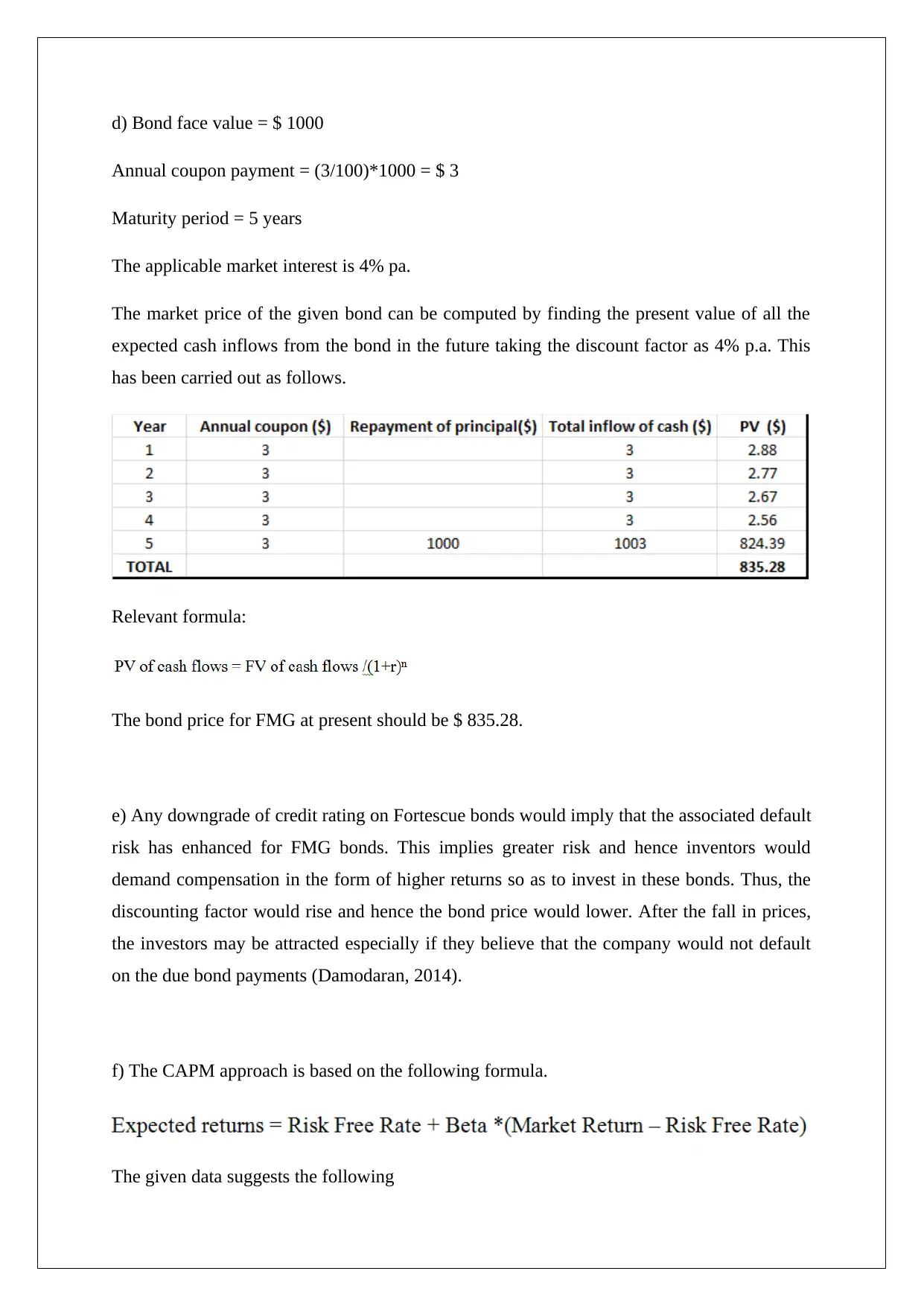
d) Bond face value = $ 1000
Annual coupon payment = (3/100)*1000 = $ 3
Maturity period = 5 years
The applicable market interest is 4% pa.
The market price of the given bond can be computed by finding the present value of all the
expected cash inflows from the bond in the future taking the discount factor as 4% p.a. This
has been carried out as follows.
Relevant formula:
The bond price for FMG at present should be $ 835.28.
e) Any downgrade of credit rating on Fortescue bonds would imply that the associated default
risk has enhanced for FMG bonds. This implies greater risk and hence inventors would
demand compensation in the form of higher returns so as to invest in these bonds. Thus, the
discounting factor would rise and hence the bond price would lower. After the fall in prices,
the investors may be attracted especially if they believe that the company would not default
on the due bond payments (Damodaran, 2014).
f) The CAPM approach is based on the following formula.
The given data suggests the following
Annual coupon payment = (3/100)*1000 = $ 3
Maturity period = 5 years
The applicable market interest is 4% pa.
The market price of the given bond can be computed by finding the present value of all the
expected cash inflows from the bond in the future taking the discount factor as 4% p.a. This
has been carried out as follows.
Relevant formula:
The bond price for FMG at present should be $ 835.28.
e) Any downgrade of credit rating on Fortescue bonds would imply that the associated default
risk has enhanced for FMG bonds. This implies greater risk and hence inventors would
demand compensation in the form of higher returns so as to invest in these bonds. Thus, the
discounting factor would rise and hence the bond price would lower. After the fall in prices,
the investors may be attracted especially if they believe that the company would not default
on the due bond payments (Damodaran, 2014).
f) The CAPM approach is based on the following formula.
The given data suggests the following
Paraphrase This Document
Need a fresh take? Get an instant paraphrase of this document with our AI Paraphraser
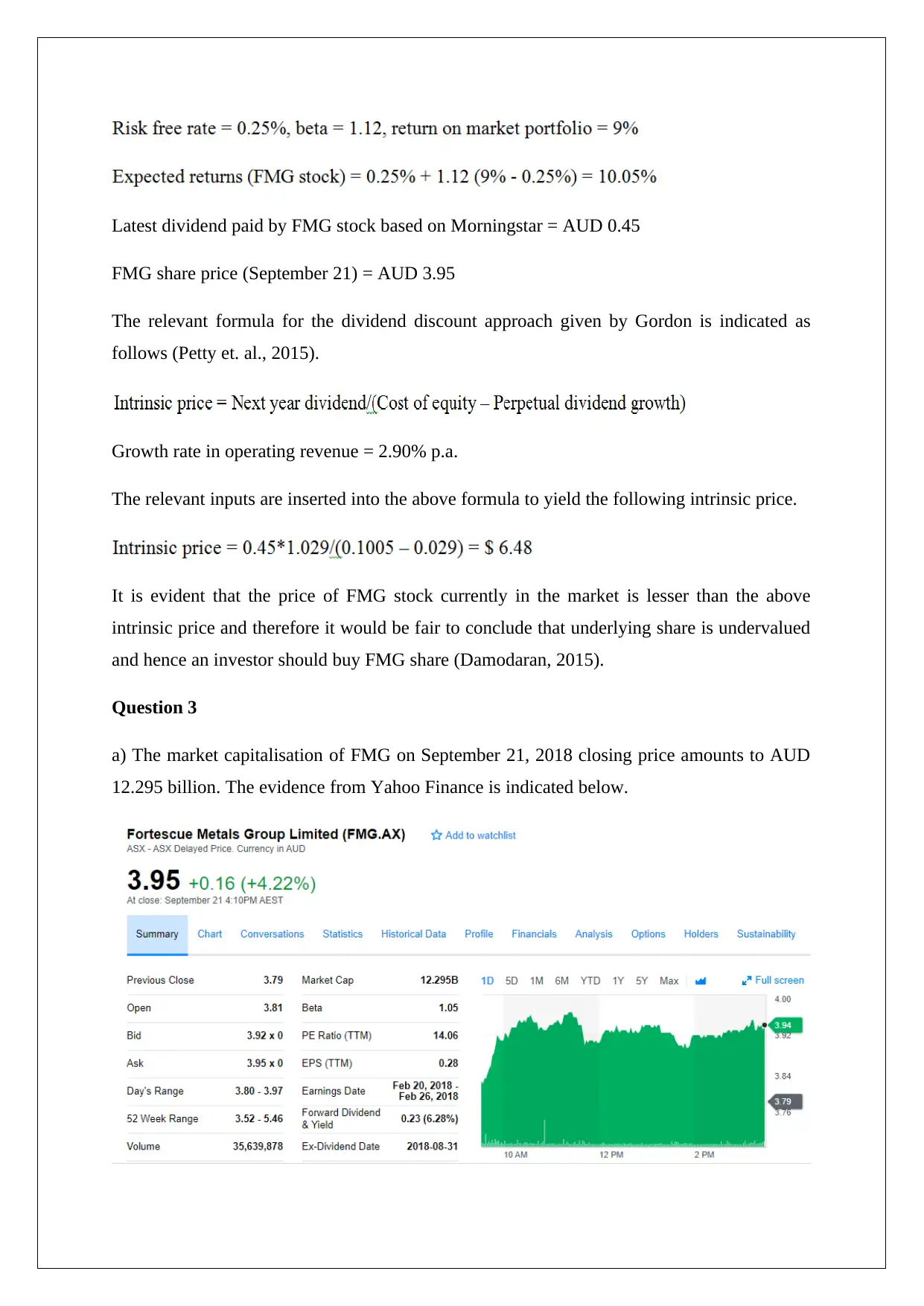
Latest dividend paid by FMG stock based on Morningstar = AUD 0.45
FMG share price (September 21) = AUD 3.95
The relevant formula for the dividend discount approach given by Gordon is indicated as
follows (Petty et. al., 2015).
Growth rate in operating revenue = 2.90% p.a.
The relevant inputs are inserted into the above formula to yield the following intrinsic price.
It is evident that the price of FMG stock currently in the market is lesser than the above
intrinsic price and therefore it would be fair to conclude that underlying share is undervalued
and hence an investor should buy FMG share (Damodaran, 2015).
Question 3
a) The market capitalisation of FMG on September 21, 2018 closing price amounts to AUD
12.295 billion. The evidence from Yahoo Finance is indicated below.
FMG share price (September 21) = AUD 3.95
The relevant formula for the dividend discount approach given by Gordon is indicated as
follows (Petty et. al., 2015).
Growth rate in operating revenue = 2.90% p.a.
The relevant inputs are inserted into the above formula to yield the following intrinsic price.
It is evident that the price of FMG stock currently in the market is lesser than the above
intrinsic price and therefore it would be fair to conclude that underlying share is undervalued
and hence an investor should buy FMG share (Damodaran, 2015).
Question 3
a) The market capitalisation of FMG on September 21, 2018 closing price amounts to AUD
12.295 billion. The evidence from Yahoo Finance is indicated below.
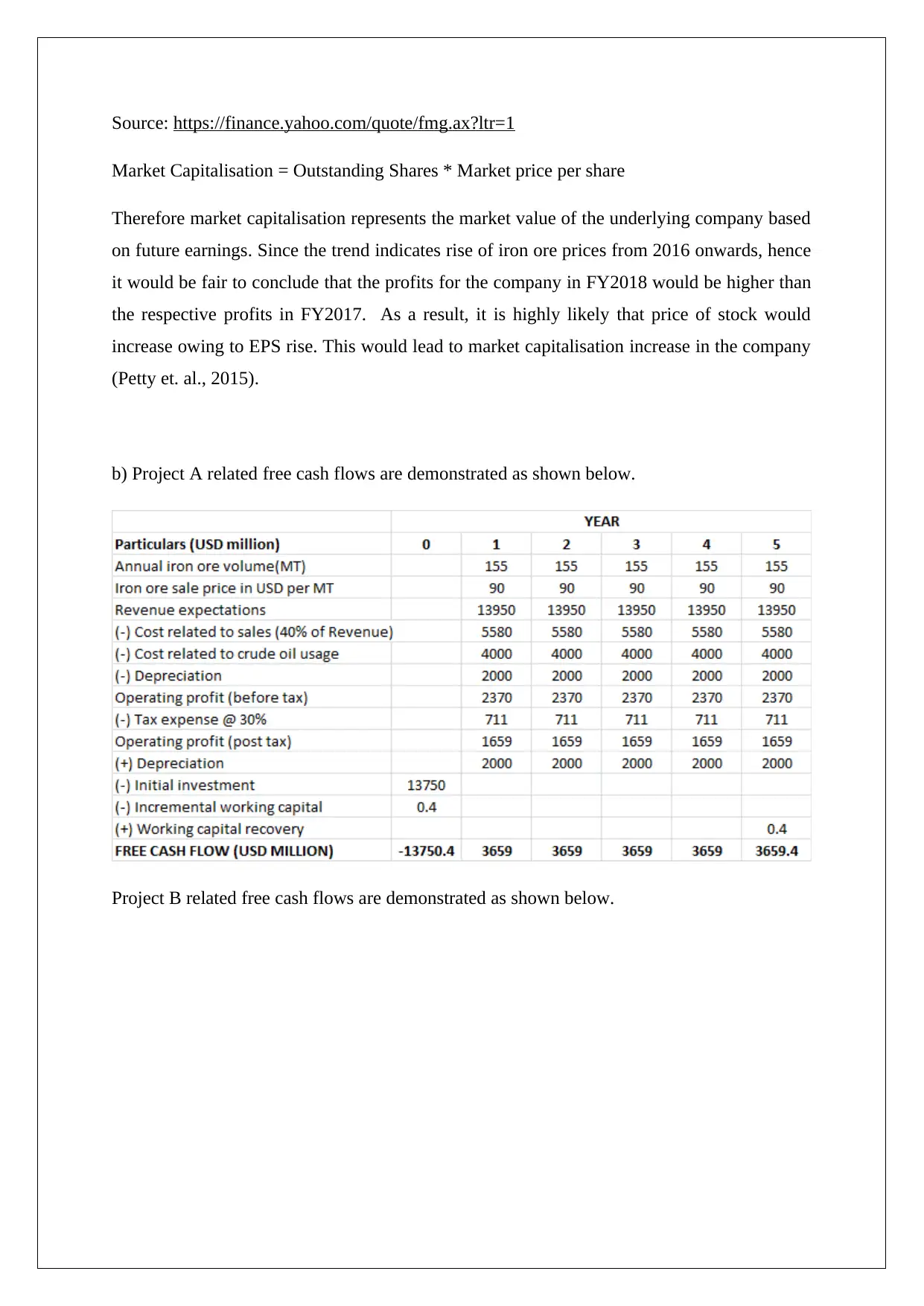
Source: https://finance.yahoo.com/quote/fmg.ax?ltr=1
Market Capitalisation = Outstanding Shares * Market price per share
Therefore market capitalisation represents the market value of the underlying company based
on future earnings. Since the trend indicates rise of iron ore prices from 2016 onwards, hence
it would be fair to conclude that the profits for the company in FY2018 would be higher than
the respective profits in FY2017. As a result, it is highly likely that price of stock would
increase owing to EPS rise. This would lead to market capitalisation increase in the company
(Petty et. al., 2015).
b) Project A related free cash flows are demonstrated as shown below.
Project B related free cash flows are demonstrated as shown below.
Market Capitalisation = Outstanding Shares * Market price per share
Therefore market capitalisation represents the market value of the underlying company based
on future earnings. Since the trend indicates rise of iron ore prices from 2016 onwards, hence
it would be fair to conclude that the profits for the company in FY2018 would be higher than
the respective profits in FY2017. As a result, it is highly likely that price of stock would
increase owing to EPS rise. This would lead to market capitalisation increase in the company
(Petty et. al., 2015).
b) Project A related free cash flows are demonstrated as shown below.
Project B related free cash flows are demonstrated as shown below.
⊘ This is a preview!⊘
Do you want full access?
Subscribe today to unlock all pages.

Trusted by 1+ million students worldwide

(ii) The project NPV for the given projects A and B can be estimated with the use of 12%
WACC as provided in the question.
(iii) The discount rate which tends to result in NPV becoming zero would be called as IRR.
Based on the free cash flow estimated for the two projects, IRR is highlighted as follows.
The period over which the total discounted cash flow would recover the investment initially
undertaken in the project is referred to as discounted payback period.
In case of project A. discounted payback period is non-existent since the project discounted
cash flow over the useful life also cannot recover the initial investment.
Project B discounted payback period (Computation in excel sheet) = 3.78 years
(iv) The appropriate choice of the superior project need to be based from the relevant capital
budgeting parameters. This is indicated as shown below (Damodaran, 2015).
WACC as provided in the question.
(iii) The discount rate which tends to result in NPV becoming zero would be called as IRR.
Based on the free cash flow estimated for the two projects, IRR is highlighted as follows.
The period over which the total discounted cash flow would recover the investment initially
undertaken in the project is referred to as discounted payback period.
In case of project A. discounted payback period is non-existent since the project discounted
cash flow over the useful life also cannot recover the initial investment.
Project B discounted payback period (Computation in excel sheet) = 3.78 years
(iv) The appropriate choice of the superior project need to be based from the relevant capital
budgeting parameters. This is indicated as shown below (Damodaran, 2015).
Paraphrase This Document
Need a fresh take? Get an instant paraphrase of this document with our AI Paraphraser
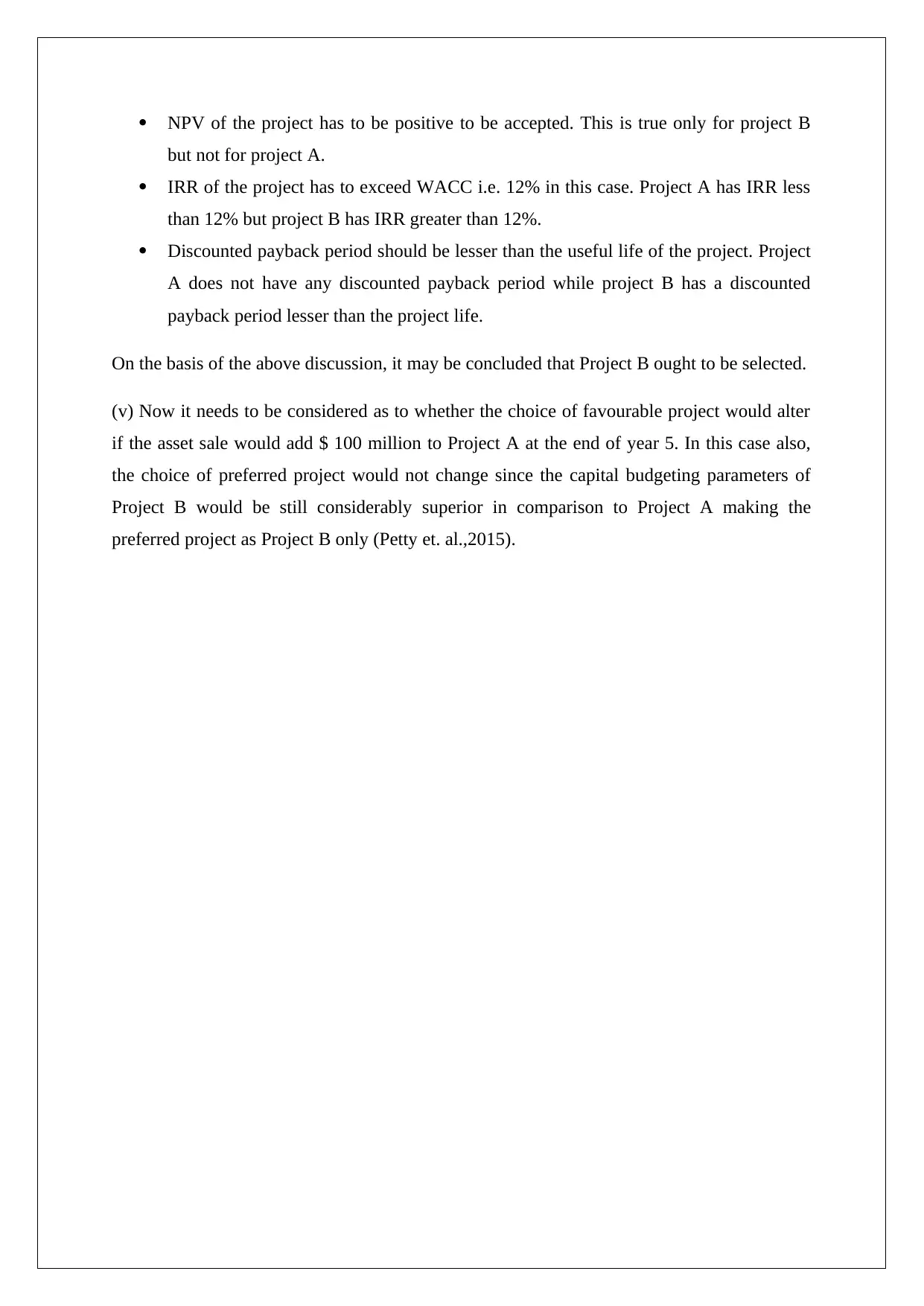
NPV of the project has to be positive to be accepted. This is true only for project B
but not for project A.
IRR of the project has to exceed WACC i.e. 12% in this case. Project A has IRR less
than 12% but project B has IRR greater than 12%.
Discounted payback period should be lesser than the useful life of the project. Project
A does not have any discounted payback period while project B has a discounted
payback period lesser than the project life.
On the basis of the above discussion, it may be concluded that Project B ought to be selected.
(v) Now it needs to be considered as to whether the choice of favourable project would alter
if the asset sale would add $ 100 million to Project A at the end of year 5. In this case also,
the choice of preferred project would not change since the capital budgeting parameters of
Project B would be still considerably superior in comparison to Project A making the
preferred project as Project B only (Petty et. al.,2015).
but not for project A.
IRR of the project has to exceed WACC i.e. 12% in this case. Project A has IRR less
than 12% but project B has IRR greater than 12%.
Discounted payback period should be lesser than the useful life of the project. Project
A does not have any discounted payback period while project B has a discounted
payback period lesser than the project life.
On the basis of the above discussion, it may be concluded that Project B ought to be selected.
(v) Now it needs to be considered as to whether the choice of favourable project would alter
if the asset sale would add $ 100 million to Project A at the end of year 5. In this case also,
the choice of preferred project would not change since the capital budgeting parameters of
Project B would be still considerably superior in comparison to Project A making the
preferred project as Project B only (Petty et. al.,2015).
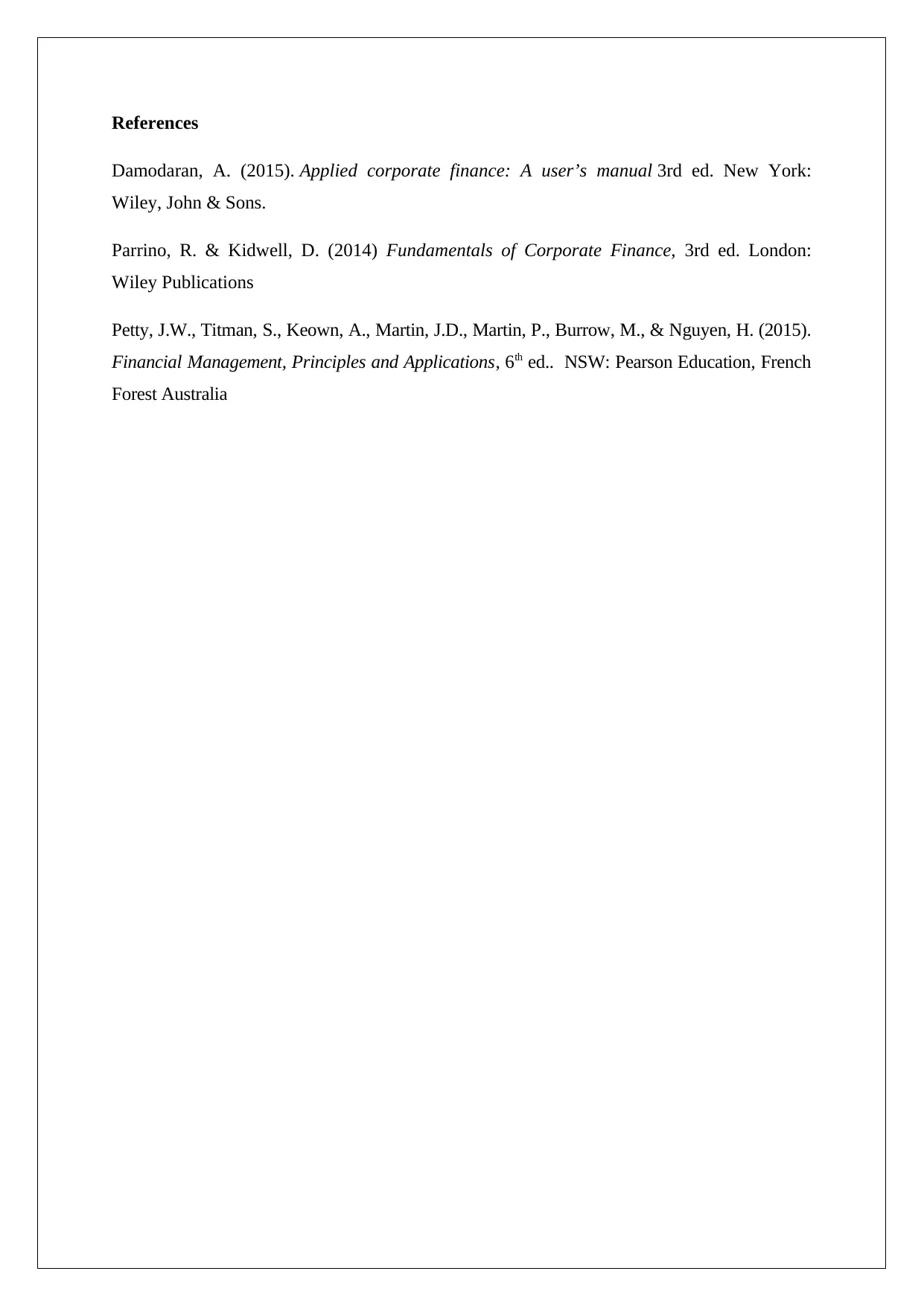
References
Damodaran, A. (2015). Applied corporate finance: A user’s manual 3rd ed. New York:
Wiley, John & Sons.
Parrino, R. & Kidwell, D. (2014) Fundamentals of Corporate Finance, 3rd ed. London:
Wiley Publications
Petty, J.W., Titman, S., Keown, A., Martin, J.D., Martin, P., Burrow, M., & Nguyen, H. (2015).
Financial Management, Principles and Applications, 6th ed.. NSW: Pearson Education, French
Forest Australia
Damodaran, A. (2015). Applied corporate finance: A user’s manual 3rd ed. New York:
Wiley, John & Sons.
Parrino, R. & Kidwell, D. (2014) Fundamentals of Corporate Finance, 3rd ed. London:
Wiley Publications
Petty, J.W., Titman, S., Keown, A., Martin, J.D., Martin, P., Burrow, M., & Nguyen, H. (2015).
Financial Management, Principles and Applications, 6th ed.. NSW: Pearson Education, French
Forest Australia
⊘ This is a preview!⊘
Do you want full access?
Subscribe today to unlock all pages.

Trusted by 1+ million students worldwide
1 out of 9
Related Documents
Your All-in-One AI-Powered Toolkit for Academic Success.
+13062052269
info@desklib.com
Available 24*7 on WhatsApp / Email
![[object Object]](/_next/static/media/star-bottom.7253800d.svg)
Unlock your academic potential
Copyright © 2020–2025 A2Z Services. All Rights Reserved. Developed and managed by ZUCOL.




